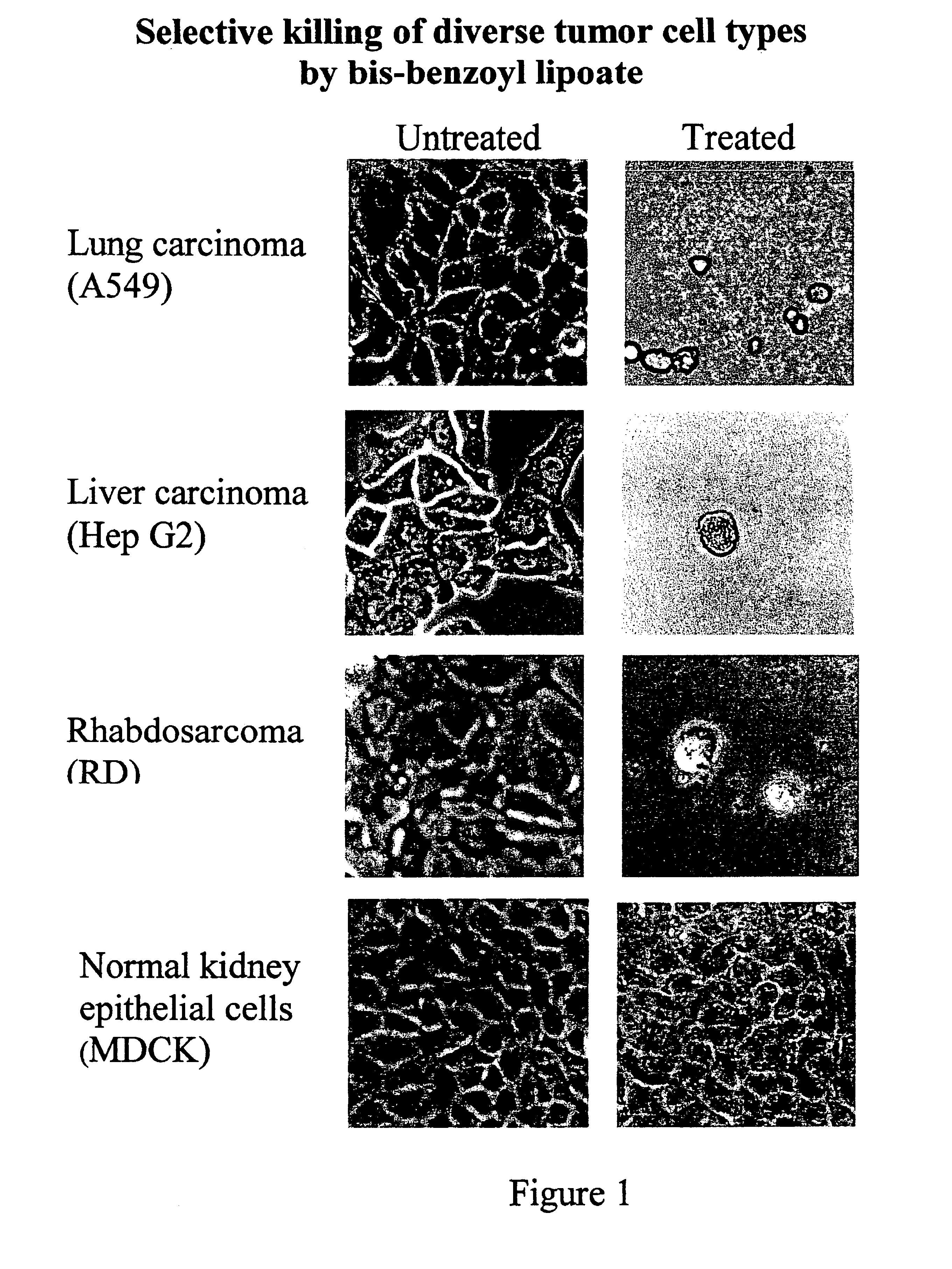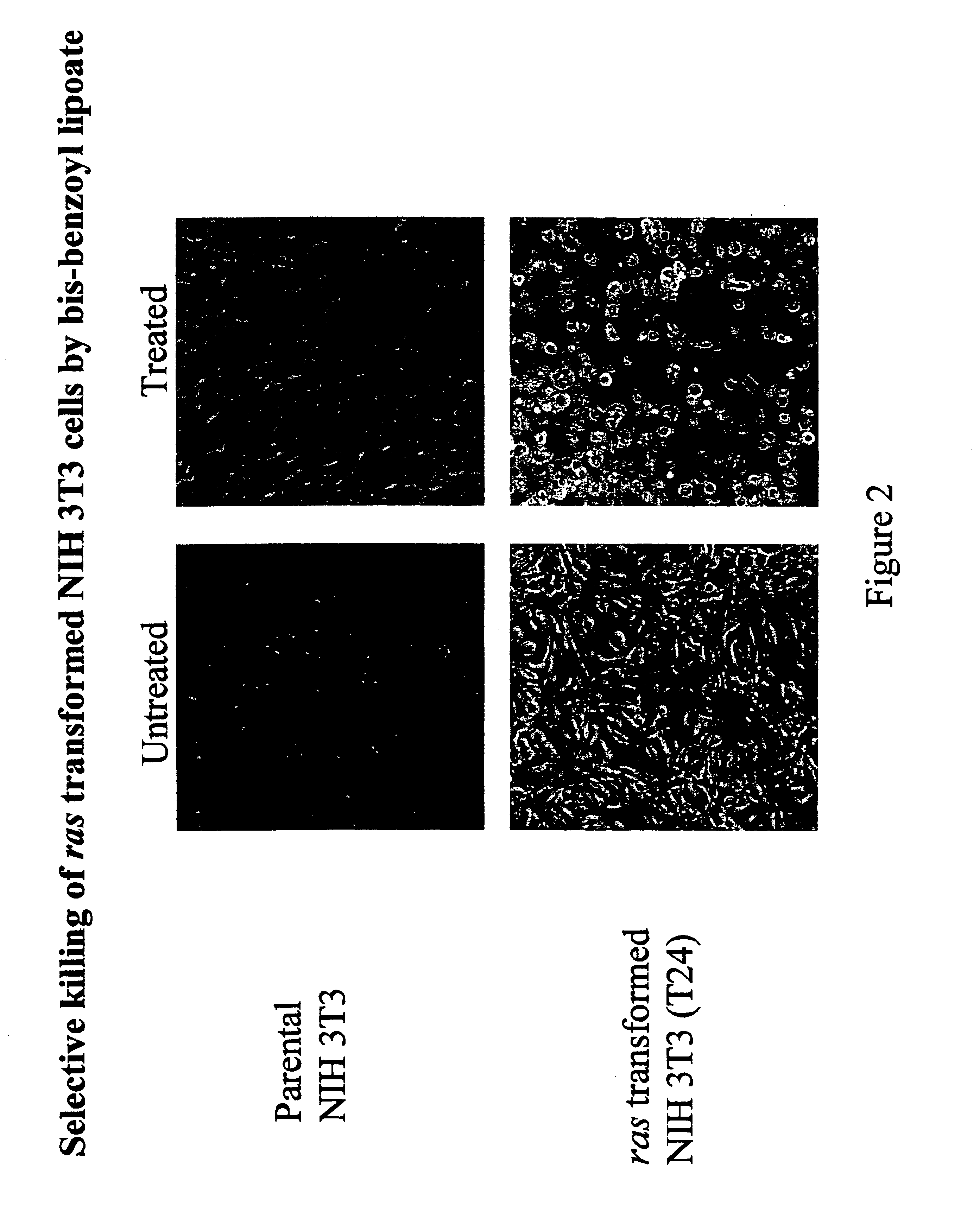Lipoic acid derivatives and their use in treatment of disease
a technology of lipoic acid and derivatives, which is applied in the field of lipoic acid derivatives and their use in the treatment of diseases, can solve the problems of poor prognosis of cytotoxic chemotherapy, rapid disease progression with poor prognosis, and many malignant diseases that continue to present major challenges to clinical oncology, and achieves low staining level and effective inhibition of tumor cells in patients
- Summary
- Abstract
- Description
- Claims
- Application Information
AI Technical Summary
Benefits of technology
Problems solved by technology
Method used
Image
Examples
example 1
[0061]The synthetic conditions allowing the production of a metal / lipoate derivative is described here as follows:[0062]PtCl2 was obtained from Alfa Aesar, DL-alpha lipoic acid from USB, all other chemicals from Fisher. The formulation given produces a final volume of 1 mL of the platinum / lipoate derivative solutuion.[0063]1. Suspend 10.64 mg PtCl2 in 215 ul of 3.5N HCL.[0064]2. Heat for 15 minutes at 65° C.[0065]3. Centrifuge for 6 minutes at room temperature at 10,000×g and recover cleared supernatant.[0066]4. Dissolve 114 mg of NaOH in 1.5 ml of H2O.[0067]5. Add 82 mg of DL-alpha lipoic acid to the NaOH solution from step 4 and dissolve.[0068]6. Transfer 150 ul of the Sodium lipoate solution from step 5 into a fresh tube and add 22 ul of the cleared platinum chloride supernatant from step 3.[0069]7. Mix until all precipitate dissolves.[0070]8. Heat at 65° C. for 15 minutes.[0071]9. Bring to final volume of 1 ml with distilled H2O.
example 2
[0072]In order to confirm the existence of a large, new class of anti-cancer agents consisting of blocked and / or disabled lipoic acid derivatives, a number of new lipoic acid derivatives have been synthesized and tested. In this and the following five EXAMPLES (2-7), the synthesis, structure and purification of six compounds are described. These compounds are then tested in later EXAMPLES (8-15).
[0073]Preparation of 6,8-bisacetylmercaptooctanoic acid (bis-acetyl lipoic acid)
[0074]6,8-bisacetylmercaptooctanoic (henceforth referred to as bis-acetyl lipoic acid) was prepared from commercially available—lipoic acid using a three step procedure. These steps were as follows: Lipoic acid was first reduced to 6,8-bismercaptooctanoic acid which was then acetylated to produce 6,8-bisacetylmercaptooctanoic acetic anhydride. This 6,8-bisacetylmercaptooctanoic acetic anhydride was then selectively hydrolyzed to produce the 6,8-bisacetylmercaptooctanoic acid.
[0075]In detail these steps were accom...
example 3
[0090]Preparation of 6,8-bisbenzoylmercaptooctanoic acid (bisbenzoyl lipoic acid)
[0091]In overview, 6,8-Bisbenzoylmercaptooctanoic acid was prepared by a three step procedure from commercially available α-lipoic acid. The lipoic acid was first reduced to 6,8-bismercaptooctanoic acid with sodium borohydride in water under slightly alkaline conditions. The product was benzoylated with three equivalents of benzoyl chloride in the presence of triethylamine to scavenge the HCl byproduct to produce 6,8-bisbenzoylmercaptooctanoic benzoic anhydride. The anhydride was selectively hydrolyzed with dioxane / water to produce 6,8-bisbenzoylmercaptooctanoic acid without any undesired hydrolysis of the benzoylthio ester groups. The product was purified by column chromatography on Silica Gel. The purified acid was dissolved in methanol and converted to the sodium salt by the slow addition of an aqueous solution containing one mole equivalent of sodium bicarbonate.
[0092]In detail these step were carri...
PUM
| Property | Measurement | Unit |
|---|---|---|
| volume | aaaaa | aaaaa |
| volume | aaaaa | aaaaa |
| volume | aaaaa | aaaaa |
Abstract
Description
Claims
Application Information
 Login to View More
Login to View More - R&D
- Intellectual Property
- Life Sciences
- Materials
- Tech Scout
- Unparalleled Data Quality
- Higher Quality Content
- 60% Fewer Hallucinations
Browse by: Latest US Patents, China's latest patents, Technical Efficacy Thesaurus, Application Domain, Technology Topic, Popular Technical Reports.
© 2025 PatSnap. All rights reserved.Legal|Privacy policy|Modern Slavery Act Transparency Statement|Sitemap|About US| Contact US: help@patsnap.com



